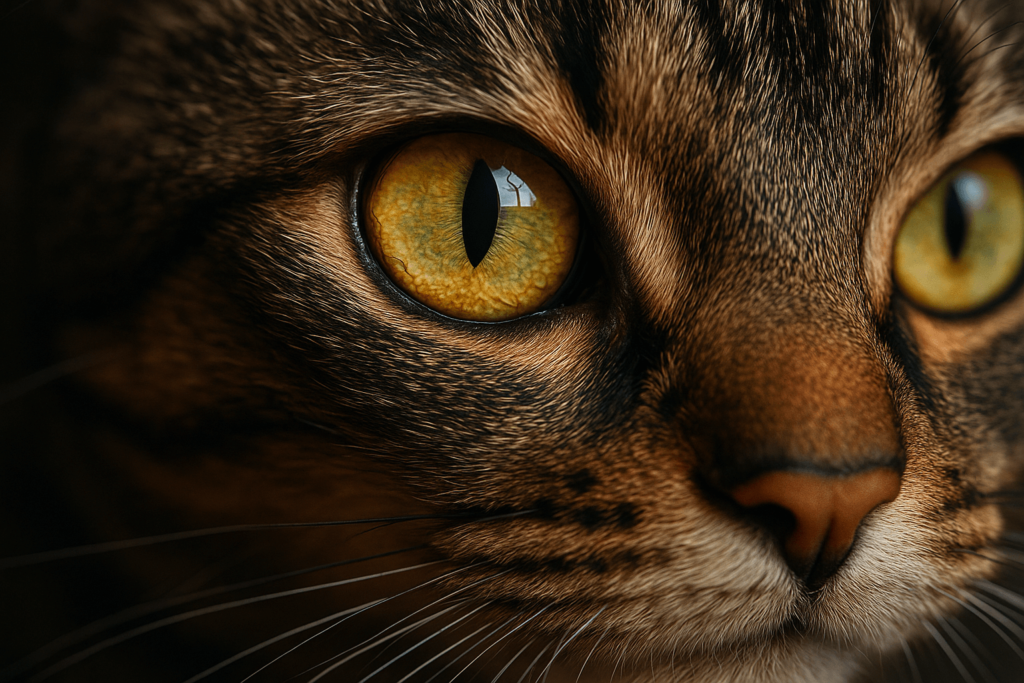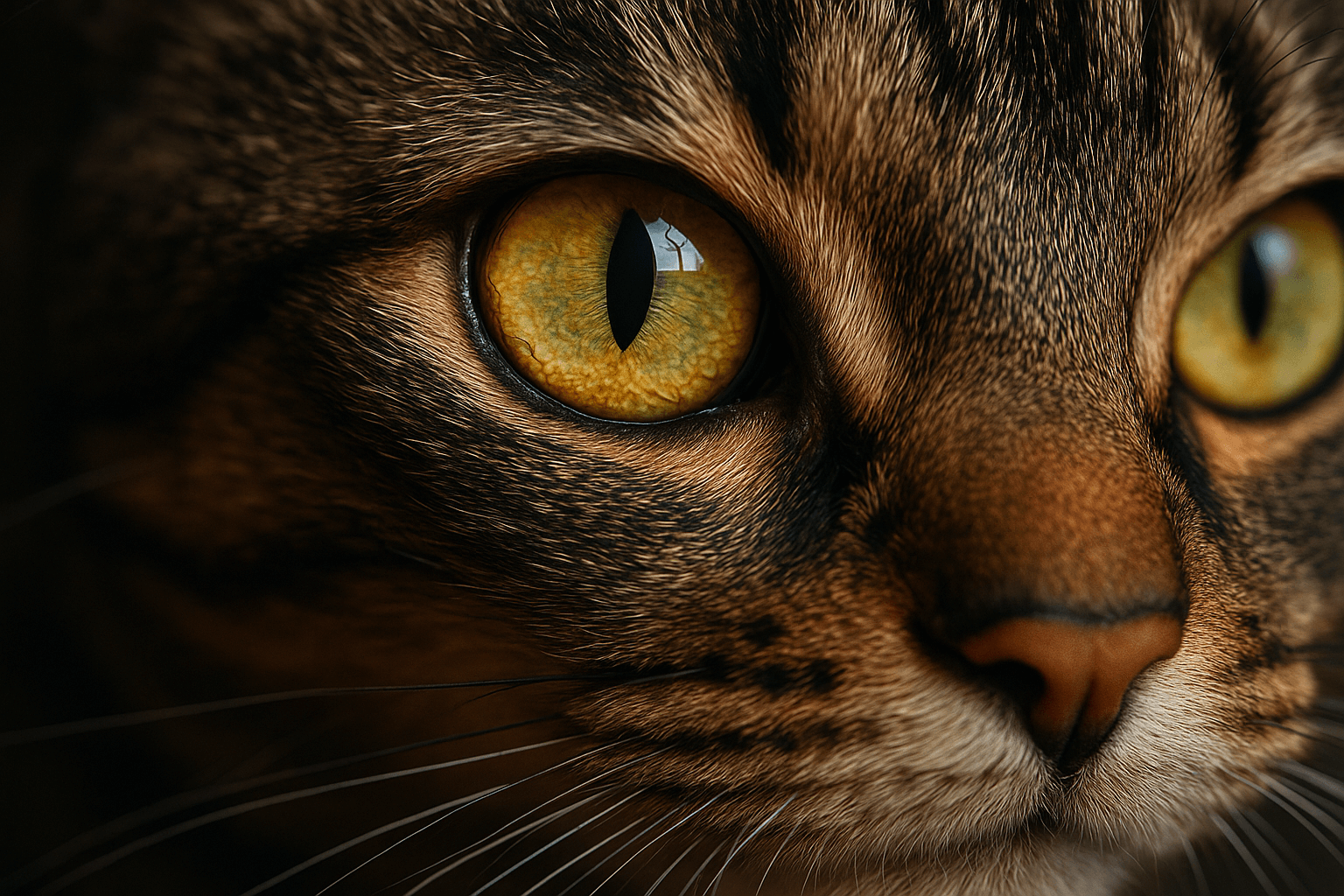Understanding Cat Eye Language
Cats are masters of subtle communication, and their eyes play a vital role in expressing emotions, intentions, and even health. While we often focus on their vocalizations or body posture, understanding cat eye language can deepen your bond with your feline friend and help you interpret their needs more effectively. From slow blinks to dilated pupils, every movement or change in their eyes tells a story. In this blog post, we’ll explore the fascinating world of cat eye language, uncovering what your cat is trying to tell you through their gaze, blink patterns, and other visual cues.
Decoding Common Cat Eye Signals
Your cat’s eyes are like windows into their soul, revealing how they feel in any given moment. Here are some common signals and what they mean.
Slow Blinks:
A slow blink from your cat is a sign of trust and affection. It’s their way of saying, “I feel safe around you.”Dilated Pupils:
Dilated pupils can indicate excitement, fear, or aggression. Context matters—watch for accompanying body language to understand their mood.Constricted Pupils:
Constricted pupils often signal tension or irritation. Your cat might be feeling threatened or annoyed by something in their environment.Staring Without Blinking:
Prolonged staring is a sign of dominance or curiosity. In multi-cat households, it can also signal a challenge or territorial behavior.Half-Closed Eyes:
When your cat’s eyes are partially closed, it usually means they’re relaxed and content, trusting their surroundings completely.
By observing these eye signals, you can better understand your cat’s emotional state and respond appropriately to their needs.

What Your Cat’s Gaze Can Reveal About Their Health
A cat’s eyes not only communicate emotions but can also provide clues about their physical well-being. Changes in their eyes may indicate underlying health issues that require attention.
Cloudy or Discolored Eyes:
Cloudiness or unusual discoloration could be a sign of cataracts, glaucoma, or other eye conditions requiring veterinary care.Excessive Tearing or Discharge:
Watery eyes or discharge might point to infections, allergies, or blocked tear ducts. Monitor for redness or swelling as additional warning signs.Squinting or Avoiding Light:
If your cat frequently squints or avoids bright lights, it could indicate pain, inflammation, or sensitivity due to an injury or illness.Unequal Pupil Sizes:
Uneven pupil dilation (anisocoria) can suggest neurological issues, trauma, or other serious conditions that need immediate evaluation.Frequent Blinking or Rubbing:
Excessive blinking or pawing at the eyes may indicate discomfort caused by foreign objects, infections, or irritants.
Paying attention to these signs ensures early detection of potential problems, keeping your cat healthy and comfortable.
Check this guide 👉Understanding Cat Ear Body Language: Best 7 Expert Tips!
Check this guide 👉Understanding Your Cats Love Language: Best 7 Expert Tips!
Check this guide 👉Decoding Sick Cat Body Language: Best 7 Health Tips!
Cat Eye Signal | Possible Meaning |
|---|---|
Slow blink | Trust and affection |
Dilated pupils | Excitement, fear, or aggression |
Constricted pupils | Irritation or tension |
Half-closed eyes | Relaxation and contentment |
Staring without blinking | Curiosity, dominance, or territoriality |
How to Respond to Your Cat’s Eye Language
Understanding your cat’s eye language is just the first step—knowing how to respond appropriately strengthens your connection and ensures their comfort.
Return a Slow Blink:
If your cat gives you a slow blink, reciprocate with one of your own. This reinforces mutual trust and affection.Avoid Direct Staring:
Staring directly into your cat’s eyes can make them feel uneasy. Instead, use soft, indirect gazes to show respect for their space.Approach Calmly During Dilated Pupils:
If your cat’s pupils are dilated due to fear or stress, approach slowly and calmly to avoid escalating their anxiety.Check for Environmental Triggers:
Observe what might be causing constricted pupils or squinting, such as loud noises or bright lights, and adjust accordingly.Seek Veterinary Help for Abnormalities:
If you notice persistent changes in your cat’s eyes, consult a vet promptly to rule out medical concerns.
Responding thoughtfully to your cat’s eye language fosters a deeper bond and helps maintain their emotional and physical well-being.
The Role of Eye Contact in Building Trust
Eye contact plays a crucial role in building trust between humans and cats. Using your cat’s eye language effectively can enhance your relationship over time.
Use Soft Gazes:
Soft, gentle eye contact reassures your cat that you’re not a threat, encouraging them to relax in your presence.Respect Their Boundaries:
If your cat breaks eye contact or looks away, give them space—they may need time to process their feelings.Engage in Playful Eye Interaction:
During playtime, use animated expressions and eye movements to engage your cat’s natural curiosity and hunting instincts.Observe Consistency Over Time:
Regularly observing your cat’s eye behavior helps you notice subtle shifts in their mood or personality.Combine Eye Language with Other Cues:
Pair eye signals with body posture and vocalizations for a holistic understanding of your cat’s communication style.
Building trust through eye contact creates a foundation of mutual understanding and strengthens your bond with your feline companion.
Signs of Stress in Cat Eye Language
Stress can manifest in various ways through a cat’s eye language. Recognizing these signs allows you to intervene and provide comfort when needed.
Rapid Pupil Changes:
Frequent dilation and constriction may indicate heightened stress or anxiety.Avoidance of Eye Contact:
Cats avoiding eye contact might feel overwhelmed or threatened by their surroundings.Wide-Eyed Staring:
Wide eyes combined with tense body posture often signify fear or readiness to flee.Blinking Too Much or Not Enough:
Excessive blinking can reflect discomfort, while minimal blinking might suggest alertness or unease.Flattened Ears with Wide Eyes:
This combination indicates extreme fear or defensiveness, requiring immediate reassurance.
Understanding these stress signals empowers you to support your cat during challenging moments.
Fun Facts About Cat Eyes
Cats’ eyes are not only expressive but also fascinating from a biological perspective. Here are some intriguing facts about feline vision.
Night Vision Superpowers:
Cats have six to eight times more rod cells than humans, enabling superior night vision.Unique Pupil Shapes:
Vertical slit-shaped pupils allow cats to control light intake precisely, aiding in hunting and navigation.Color Perception Differences:
Cats see fewer colors than humans but excel at detecting motion and contrast.Third Eyelid Functionality:
The nictitating membrane (third eyelid) protects and moistens the eye while maintaining visibility.Whisker Integration:
Cats use their whiskers alongside their eyes to judge spatial awareness and detect nearby objects.
These fun facts highlight the incredible adaptations that make cat eyes so remarkable.
Tips for Enhancing Eye Communication with Your Cat
Improving your ability to communicate through eye language can enrich your relationship with your cat. Here are some practical tips to get started.
Practice Slow Blinks Daily:
Incorporate slow blinks into your daily interactions to reinforce trust and affection.Observe Subtle Changes:
Pay close attention to small shifts in your cat’s eye behavior to catch early signs of mood or health changes.Use Positive Reinforcement:
Reward your cat with treats or praise when they respond positively to your eye gestures.Create a Calm Environment:
Minimize stressors like loud noises or sudden movements to encourage relaxed eye contact.Be Patient and Observant:
Building fluency in cat eye language takes time, so remain patient as you learn to interpret their signals.
With dedication and practice, mastering cat eye language becomes second nature, enhancing your connection with your beloved pet.
Frequently Asked Questions About Cat Eye Language
Why does my cat stare at me?
Your cat may be curious, seeking attention, or simply enjoying your presence. Prolonged staring isn’t always aggressive.
What does it mean if my cat’s eyes are half-closed?
Half-closed eyes typically indicate relaxation and trust, showing your cat feels safe and comfortable.
Why do cats slow blink at humans?
A slow blink is a gesture of love and trust, often referred to as a “cat kiss.” Returning the blink deepens your bond.
Can eye changes indicate illness?
Yes, changes like cloudiness, excessive tearing, or uneven pupils can signal health issues. Consult a vet if you notice abnormalities.
How can I tell if my cat is stressed through their eyes?
Dilated pupils, frequent blinking, or avoidance of eye contact can all indicate stress or discomfort.
Unlocking the Secrets of Cat Eye Language
Your cat’s eyes are powerful tools for communication, offering insights into their emotions, health, and overall well-being. By learning to decode their eye language, you can strengthen your bond, address potential issues early, and create a harmonious living environment for both of you. Whether it’s a slow blink of affection or a subtle shift in pupil size, every glance holds meaning. So next time your cat locks eyes with you, take a moment to appreciate the depth of their expression—it’s their unique way of connecting with you.
Understanding Cryptosporidium in Cats: Best 7 Expert Tips! – Spot symptoms, treat safely, and stop parasite spread in your home.
Understanding Cryptosporidium in Dogs: Best 7 Expert Tips! – Learn symptoms, treatment & prevention for this stubborn gut parasite.
Understanding Syringomyelia in Cats: Best 7 Expert Tips! – Recognize signs, manage pain, and support your cat’s neurological health with vet-backed guidance.
Understanding Syringomyelia in Dogs: Best 7 Expert Tips! – Expert insights on symptoms, MRI diagnosis, pain management & quality of life.





